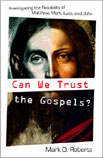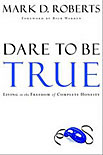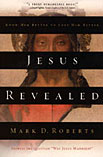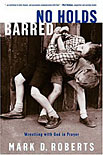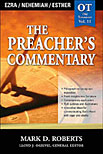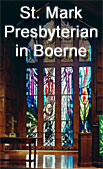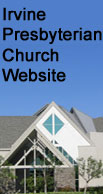My blog has moved! http://www.patheos.com/blogs/markdroberts/
|
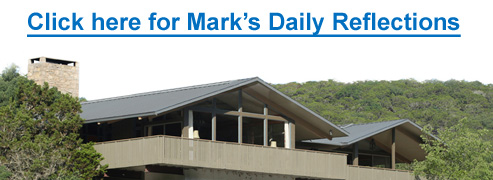 |
Twitter Feed for My Recent Blog Posts and Other Tweets |
My blog has moved! http://www.patheos.com/blogs/markdroberts/
|
A Theology of Work in Ezra?
By Mark D. Roberts | Thursday, September 3, 2009
Part 3 of series: A Theology of Work in Ezra
Permalink for this post / Permalink for this series
If you’re just now joining this series, let me say that I’m doing some blogging on a theology of work in the biblical books of Ezra, Nehemiah, and Esther. This exercise is my first step toward producing a short “commentary” on these books for the Theology of Work Project. (If you missed my explanation of TOWP, you may want to check this post.) I’m looking first at the book of Ezra, then at Nehemiah and Esther, with this question: What does this book teach us about a theology of work? Or, to put it differently: What do we learn from this book about how work relates to God and vice versa?
If you’re is looking for a biblical theology of work, you shouldn’t start with Ezra. Frankly, there is little in this book that speaks directly about work and its relationship to God. Partly this has to do with the genre of Ezra. It is a narrative, an historical narrative that describes, from a theological perspective, what happened in a key time of Israel’s history. The narrative contains nothing in the way of legal texts or prophetic pronouncements, no didactic material of any kind. You won’t find theological ruminations on work in Ezra.
You do find people working, however, and this might provide some grist for the TOWP mill. Primarily, Ezra includes two kinds of work. The first is the “work” of Israel’s sacrificial worship. Other than the giving of gifts for the rebuilding of the Temple in Jerusalem and travel from Babylon to Jerusalem, the first real work in Ezra is the building of an altar to God, on which sacrifices were then offered to God (Ezra 3:1-6). Prior to this building, a long list of names includes the professions of those who labor in some aspect of the Temple’s activity: priests, Levites, singers, gatekeepers, and temple servants (Ezra 2, esp. 2:70).
The second kind of work in Ezra is closely related to the first. It involves building, most of all, building (or rebuilding) the Temple in Jerusalem. The first six chapters of Ezra focus on this activity. In fact, the Hebrew verb “to build” (bnh) and its Aramaic cousin (for part of Ezra is written in Aramaic), appear 31 times in Ezra (in the first six chapters, to be exact). No book of the Old Testament utilizes the verb “to build” more frequently than Ezra. It is a book about building. And building is work, hard work.
I don’t what to read between the lines here too creatively, as if Ezra contains some arcane theology of work that can be decoded if we only have the secret decoder ring. This book mainly underscores what is plain elsewhere from Scripture, truths such as: Work is an ordinary part of ordinary life. Work is something for which God has given us the ability. Work can be hard. Work takes organization. Work matters to God. Yet it would be stretching things to say that Ezra teaches these truths. They are more like background assumptions, part of Ezra’s theological worldview.
Ezra does offer a theologically engaging account of the relationship between human work and God’s help. We find this especially in Ezra 5. In context, the rebuilding of the Temple in Jerusalem came to a standstill because of opposition to this effort from various opponents (4:24). But God, speaking through his prophets Haggai and Zechariah, helped to get the project going again (5:1-2). Nothing could derail it this time. Thus the temple-building part of Ezra ends with good news:
So the elders of the Jews continued to build and prosper under the preaching of Haggai the prophet and Zechariah, a descendant of Iddo. They finished building the temple according to the command of the God of Israel and the decrees of Cyrus, Darius and Artaxerxes, kings of Persia. (6:14)
What enabled the Temple to be rebuilt following the Exile? To be sure, it took plenty of hard work by the leaders of the Jews and by the expert craftsmen whom they paid to help (3:7). And, of course, it would not have happened apart from the initial decree of Cyrus and the continued support of the Persian rulers. But God’s hand empowered and guided the rebuilding effort, both in raising up Cyrus to do his bidding and in emboldening the leaders of the Jews through the prophecies of Haggai and Zechariah.
The book of Ezra, therefore, underscores the value of human labor and leadership. But it also reminds us that, apart from God’s superintendence, human work is ultimately in vain.
Topics: Theology of Work Project | No Comments »
An Introduction to Ezra
By Mark D. Roberts | Wednesday, September 2, 2009
Part 2 of series: A Theology of Work in Ezra
Permalink for this post / Permalink for this series
The Old Testament book of Ezra was originally the first part of one continuous work that included the book we call Nehemiah as the second part. The story of Ezra-Nehemiah was written as a continuous narrative.
We don’t know much about the writer of Ezra-Nehemiah, other than what we can glean from the books themselves. It’s evident that the writer, who was either the same person or someone closely related to the person who wrote 1 and 2 Chronicles, used a number of primary sources in telling the story of the rebuilding of Jerusalem and its Temple after the Babylonian exile. The date of writing must have been later than 430 B.C., when the action of Nehemiah concludes, and probably occurred before 300 B.C.
The theme of restoration pervades Ezra-Nehemiah. In my commentary I utilized the following basic outline for these books:
1. Restoration of the Temple (Ezra 1:1-6:22)
2. Restoration of Covenant Life, Phase One: The Work of Ezra (Ezra 7:1-10:44)
3. Restoration of the Wall through Nehemiah (Neh 1:1-6:19)
4. Restoration of Covenant Life, Phase Two: Ezra and Nehemiah Work Together (New 7:1-13:31)
Notice that Ezra himself does not appear in the book the bears his name until the last four of its ten chapters.
The two-volume work of Ezra-Nehemiah make sense in light of the covenant between God and Israel forged at Mt. Sinai. There, God entered into a covenant relationship with Israel, promising to bless the nation if the people would only be faithful to God by obeying his law. Unfaithfulness would lead to divine judgment. Unfortunately, the Israelites persistently rebelled against God, rejecting his law and pursuing other gods. Thus God’s judgment fell upon his people, with the final blow delivered in 587 B.C. by the Babylonians under the leadership of King Nebuchadnezzar. They killed the leaders of Judah, burned the temple in Jerusalem to the ground, and took the finest of Jerusalem’s citizens back to Babylon. Thus began the Exile.
The book of Ezra begins to tell the story of restoration after the Exile, as the Israelites are returned to Jerusalem in order to rebuild their Temple as well as their life as a covenant community. Here’s how the narrative begins:
1 In the first year of Cyrus king of Persia, in order to fulfill the word of the LORD spoken by Jeremiah, the LORD moved the heart of Cyrus king of Persia to make a proclamation throughout his realm and to put it in writing: 2 “This is what Cyrus king of Persia says: “‘The LORD, the God of heaven, has given me all the kingdoms of the earth and he has appointed me to build a temple for him at Jerusalem in Judah. 3 Anyone of his people among you — may his God be with him, and let him go up to Jerusalem in Judah and build the temple of the LORD, the God of Israel, the God who is in Jerusalem. 4 And the people of any place where survivors may now be living are to provide him with silver and gold, with goods and livestock, and with freewill offerings for the temple of God in Jerusalem.’” (Ezra 1:1-4, NIV)
After Cyrus overthrew Babylon in 539 B.C., he authorized the rebuilding of the Temple in Jerusalem. His action fulfilled the prophecy of Jeremiah concerning the length of the Exile. But the prophet Isaiah had been even clearer about the divinely appointed role of Cyrus himself:
1 “This is what the LORD says to his anointed, to Cyrus, whose right hand I take hold of to subdue nations before him and to strip kings of their armor, to open doors before him so that gates will not be shut. . . . 4 For the sake of Jacob my servant, of Israel my chosen, I summon you by name and bestow on you a title of honor, though you do not acknowledge me. . . . 13 I will raise up Cyrus in my righteousness: I will make all his ways straight. He will rebuild my city and set my exiles free, but not for a price or reward, says the LORD Almighty.” (Isa 45:1, 4, 13)
This is the story told in the first chapters of Ezra. To those chapters I’ll turn in my next post as I consider the theology of work in Ezra.
Topics: Theology of Work Project | 1 Comment »
Introduction: Reading with an Agenda
By Mark D. Roberts | Tuesday, September 1, 2009
Part 1 of series: A Theology of Work in Ezra
Permalink for this post / Permalink for this series
Yesterday I introduced a project to which I will soon be contributing, the Theology of Work Project (TOWP). This effort includes a systematic reading of the whole Bible, looking in every book for its theology of work. In time, the findings from this particular investigation will be published as a kind of biblical commentary. I have seen some early drafts of some of the material, and it is excellent. The more I learn about this project, the more enthusiastic I become.
My particular assignment, as I explained yesterday, is to focus on the Old Testament books of Ezra, Nehemiah, and Esther. This might seem like a surprising allocation, given that my academic expertise is in New Testament. But, as you may know, several years ago I wrote a commentary on Ezra, Nehemiah, and Esther. So, though I’m not an Old Testament scholar, I do have a measure of expertise in these particular books.
Ultimately, I will produce a focused, commentary-like study of Ezra, Nehemiah, and Esther, one that seeks to answer the question: What is this book’s theology of work? I will not be publishing that production here, because it will be part of TWOP’s “library.” But I do want to work through my assigned biblical texts as a part of my blog. Not only will this give my readers a chance to think about these issues with me . . . a worthy effort, I believe. But also, I will have the chance to learn from my readers through their posted comments and emails.
But before I get to the task at hand, I want to say something about reading with an agenda.
We always approach a reading assignment with some sort of purpose or plan. When I’m on summer vacation, for example, my agenda is enjoyment. When I’m reading a book for work, usually I’m trying to glean material that will be relevant for the mission of Laity Lodge. When it comes to most reading, we want to let the text speak for itself, to tell its story or explain its point.
When I was writing my commentary on Ezra, Nehemiah, and Esther, my goal was to let these books speak in their own voice. Beyond this, I was hoping to accurately hear the voice of God. I tried not to bring to the text my own questions that we’re extrinsic to the text itself. In particular, I was not asking Ezra, Nehemiah, and Esther to offer a theology of work, since this was not the main point of these writings. Rather, I sought to let Ezra and Nehemiah speak about restoration and renewal, the primary themes of these books. And I tried to let Esther speak about living in a culture in which one doesn’t fit, a central them of this book.
Now, however, I am bringing to Ezra, Nehemiah, and Esther a question that is not the primary question of these books. Yet I am still hoping to hear what they say in some authentic way, and not merely interject my own ideas into the text. In many cases I will be listening to what is implicit in the telling of the story. In other cases I will be dealing with what is explicit, even if it isn’t the main point.
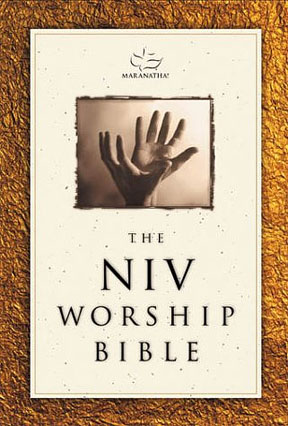 I believe that this kind of reading, when it is done with careful attention to the primary meaning(s) of a text, can be quite illuminating. I experienced such illumination a decade ago when working on the NIV Worship Bible. For this Bible, which is now out of print, I was invited to write the introductions to all of the biblical books. These introductions were not your standard study Bible fare, however, with brief notes about authorship, date, context, outline, and themes. Rather, my introductions sought to answer the question: What does this book teach us about worship?
I believe that this kind of reading, when it is done with careful attention to the primary meaning(s) of a text, can be quite illuminating. I experienced such illumination a decade ago when working on the NIV Worship Bible. For this Bible, which is now out of print, I was invited to write the introductions to all of the biblical books. These introductions were not your standard study Bible fare, however, with brief notes about authorship, date, context, outline, and themes. Rather, my introductions sought to answer the question: What does this book teach us about worship?
In order to answer this question for each biblical book, I had to read the book at least twice. As I read, I kept asking myself questions like: What does this have to do with worship? What view of worship is assumed here? And so on. In the process of writing the introductions, I learned a lot about worship. And I’m quite sure I didn’t just project my own thoughts into the text, because much of what I learned I hadn’t thought before I began my study.
So, as I get ready to look for theological material related to work in Ezra, Nehemiah, and Esther, I am bringing my agenda, if you will. This agenda is not, however, something I want to force into the text. Rather, my agenda is to ask, as openly as I can: What does this book teach us about work?
Topics: Theology of Work Project | No Comments »
Introduction to the Theology of Work Project
By Mark D. Roberts | Monday, August 31, 2009
I have recently been asked to participate in compelling new project, the Theology of Work Project. I have agreed to be involved, not only because the whole matter of faith and work lies close to the heart of Laity Lodge, but also because I think this project has potential to make a significant difference in the lives of millions of Christians and in their workplaces, and therefore, ultimately in our society as a whole.
Let me explain why I’m excited about TOWP, and therefore why I am going to be partnering with them.
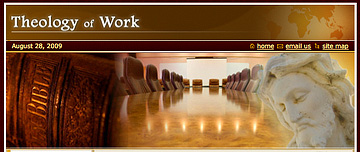 TOWP grew out of a conviction by several Christian leaders that one of the most important contexts for disciples of Jesus to live out their faith is the workplace. Yet these leaders sensed that, for millions of Christians, faith and work are separate realms. As they shared their vision with others, in time, several influential leaders joined them, including Dr. Haddon Robinson of Gordon-Conwell Theological Seminary and Tom Phillips, former CEO of Raytheon.
TOWP grew out of a conviction by several Christian leaders that one of the most important contexts for disciples of Jesus to live out their faith is the workplace. Yet these leaders sensed that, for millions of Christians, faith and work are separate realms. As they shared their vision with others, in time, several influential leaders joined them, including Dr. Haddon Robinson of Gordon-Conwell Theological Seminary and Tom Phillips, former CEO of Raytheon.
This expanded team contacted over 130 leading Christian thinkers, academics, workplace ministry professionals, and Christian workers around the world, asking if they sensed a need for a theology of work. Surprisingly, over 95% of those who had been contacted responded, with unanimous support for the development of a theology of work.
As the instigators of the project continued to push ahead, they formed a governing board of what was now called the Theology of Work Project. Serving on this board were such people as: Haddon Robinson, Tom Phillips, Daniel Byrd (professor of management at Claremont University), Katherine Leary (Exec. Dir. for Center of Faith & Work at Redeemer Presbyterian in NYC), Sean McDonough (Assoc. Prof. of NT, Gordon-Conwell), and Dave Williamson (then the Director of Laity Lodge). Of course now you can see how I got connected to this project. Dave Williamson was one of my predecessors at Laity Lodge, and, in fact, the person who first got me connected with what is now my official ministry and my unofficial passion. The TOWP has a recently-appointed Executive Editor, Dr. William Messenger. Will has extensive experience in business, the academy, and the church. He earned a BS in Physics (Case Western), an MBA (Harvard), an MDiv (Boston U), and a D.Min. (Gordon-Conwell). With his broad experience and theologically-solid vision, Will is the perfect leader for the TOWP at this time.
What is the purpose of TOWP? Here are some excerpts from their website:
• They seek to “empower the Body of Christ at every level–from individual believers to institutions like the local church–to engage workplaces, and through them, the broader cultures at large, in transformational fashion.”
• They intent do “to bring together scholars and practitioners in a coalition aimed at building consensus around fundamental truths contained in a Theology of Work consistent with orthodox historical Christianity.”
• In the end, they want “to help workers perceive God’s purpose, meaning, and value in their work, and to bring Christ’s redeeming power into the fabric of their workplaces.”
• “[TOWP] has a five-year mission to produce biblical, theological and topical materials for equipping Christians to make use of the principles and resources of the Christian faith in their daily work. It is further engaged in collecting in one place reliable research materials to aid others - including pastors, ministry professionals, Biblical scholars and teachers, and workplace practitioners - in producing materials useful to Christians in their work lives.”
TOWP seeks to fulfill this purpose through the following objectives:
(1) To assemble a Steering Committee of the most able members of its key constituencies, namely biblical scholars, theologians, ethicists, economists and organizational scientists, workers, and workplace ministers;
(2) To produce a Theology of Work that is as broadly acceptable as possible, being relevant for every kind of workplace around the world, and meeting the approval of the full spectrum of traditions within the orthodox/historical Christian faith; and,
(3) To disseminate the Theology of Work as widely as possible, to reach the millions of people who may benefit from it.
I have been asked to contribute to this project, specifically in reference to the second objective. On the way to producing a Theology of Work, the TOWP is doing an extensive and intensive study of the entire Bible, seeking for God’s wisdom with respect to work. This study, a kind of biblical commentary, will be published as a helpful tool, and will also be used a grist for the mill that produces the Theology of Work, a statement to be endorsed by a wide range of Christian leaders throughout the world (rather like the Lausanne Covenant, if you’re familiar with that document).
Specifically, my assignment is to examine the biblical books of Ezra, Nehemiah, and Esther, writing a brief commentary on these books and how they inform our theological understanding of work. Even though I am a New Testament scholar by training, I was asked to focus on these Old Testament books because I once wrote a commentary on them (originally in the Communicator’s Commentary series, now in the Preacher’s Commentary series).
As I work my way through these books, I’m going to offer some insights and reflections here in my website. I won’t be publishing here what I will submit to TOWP. But I will put up some of my thoughts in a more unpolished and speculative. I’m doing this partly to be a good steward of my time. But I’m also interested in input from my blog readers. I look forward to working in community with you as we think together about how Ezra, Nehemiah, and Esther inform our theological understanding and practice of work.
Topics: Theology of Work Project | 4 Comments »
Sunday Inspiration from The High Calling
By Mark D. Roberts | Sunday, August 30, 2009
Lead Me to the Rock
From the ends of the earth,
I cry to you for help
when my heart is overwhelmed.
Lead me to the towering rock of safety.
Psalm 61 expresses the desperate prayer of one who senses a great need for God. David prays “from the ends of the earth” (61:2). Although this could mean that he was far away from home, the sense of this phrase is more than literal. It speaks of neediness, when we are far away from what is comfortable, familiar, and safe. It may also point to times when we feel far away from God, when it seems as if he isn’t near to hear our prayers.
In such times, our hearts can become overwhelmed. The Hebrew term ‘ataf, translated here as “overwhelmed,” can also mean “faint” or “weak.” There are times when circumstances batter us, when our inner reserves are drying up. We can feel as if life is just too much for us, and that we’re not going to survive.
In such times, like David, we cry out to God for mercy. Even though God might feel far away, and even though we are emotionally spent, we nevertheless call out to God to lead us to a place of safety and security. The “towering rock of safety” is a place where the floods cannot engulf us or our enemies crush us. The rock that is literally “higher than” we are signifies God’s protection and presence.
Perhaps you’re in a place like David today, feeling far away from God and overwhelmed by the challenges before you. If so, cry out to the God who will lead you to his rock of safety. If you’re not in such a place today—thanks be to God!—I’m sure you know people who are. Their hearts might even be too faint to pray, but you can do it for them.
QUESTIONS FOR REFLECTION: When have you felt like David, far from God and completely overwhelmed? How did you pray? How did you experience God’s deliverance? What, for you, is the “towering rock of safety”?
PRAYER: O Lord, there are times when you feel so very far away, when it seems as if you aren’t even there to hear my prayers. And there are times when I am so haggard in soul that I can barely pray. Thank you for the example of David, whose desperation reminds me that I am not alone.
Thank you also for his quiet confidence in you. Help me to know that you will lead me to the towering rock of safety when I am feeling lost and exhausted.
Today I want to pray for ________. Be with them in their desperation and neediness. Reassure them. Encourage them. Lead them to the rock of your protection. Amen.
_________________________________________________
 Would you like to receive a Daily Reflection like this one in your email inbox each morning?
Would you like to receive a Daily Reflection like this one in your email inbox each morning?
Here’s how . . . .
This devotional comes from The High Calling of Our Daily Work (www.thehighcalling.org), a wonderful website about work and God. You can read my Daily Reflections there, or sign up to have them sent to your email inbox each day. This website contains lots of encouragement for people who are trying to live out their faith in the workplace.
Topics: Sunday Inspiration | No Comments »
Different Places and Their Distinctive Smells
By Mark D. Roberts | Friday, August 28, 2009
Have you ever noticed how different places have different and distinctive smells? I expect you have, especially if you’ve visited a seaside community on vacation. Even before you can hear the waves crashing on the beach or the seagulls calling, you can smell the change in the air, the hint of brine that grows ever stronger as you approah the shoreline.
Of course some places are known for their unpleasant odors. I think of a stretch of Interstate 5 in central California, where the road passes an enormous cattle ranch. Yes, you can imagine how it smells . . . something like unprocessed fertilizer.
On my recent trip to Montana, I was reminded of how wonderful certain places smell. After flying into Bozeman, we drove to Butte, where we stopped for dinner. Getting out of the car, I took a deep breath of the cool air . . . and I delighted in the smell of pine trees. There weren’t any pines nearby. But the mountains around Butte are pine covered, such that the whole area is bathed in the fresh scent of pine. Later, on some of my hikes in the mountains, the fir trees were so pungent that it seemed as if I was walking through a giant Christmas tree lot. This aroma, which might be my favorite, blesses millions of acres throughout Montana. (Photo: a trail in the Montana mountains, redolent with the sweet smell of fir trees.)
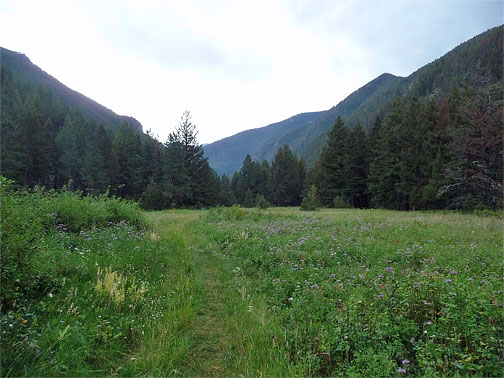
If you live in a place for a while, even for a few hours, you can quickly become immune to its distinctive scent. That’s good news if you live near a cattle ranch, but rather sad if you make your home in the mountains of Montana, or even in the Hill Country of Texas. Two years ago my family and I drove from California to Texas, the first step in our move to Boerne. I remember getting out of the car soon after we entered the Hill Country. The air smelled faintly of woodsy cinnamon, but there was nothing nearby that created the odor. I expect it was the common Hill Country combination of oak trees and what we call “cedars.” (In fact, they are Ashe Junipers.) I loved that smell as it welcomed me and my family to our new home. (Photo: A typical Hill Country scene, with hills covered by oaks and “cedars.”)
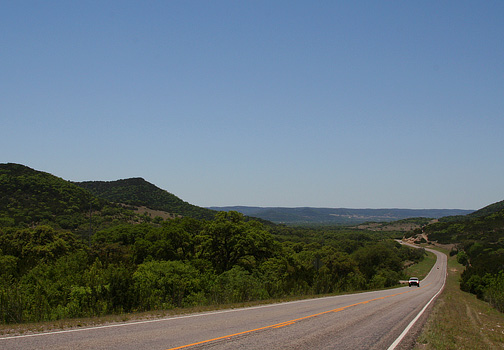
I almost never detect that smell anymore, though I expect it is all around me. Every now and then, when I return home after an out-of-town trip, I can once again enjoy the spicy fragrance of the Hill Country. But then it becomes ordinary and I stop perceiving it. Perhaps one of the gifts of a vacation is that it allows us to perceive our ordinary life, even to smell it, with fresh delight.
Have you ever been anywhere that had a distinctive smell? Where? What smell?
Thus I come to the end of my recent blog series that might be called “What I Did On My Summer Vacation.” On Monday I’ll return to more serious pursuits.
Topics: Vacation | 1 Comment »
Visiting Montana State University
By Mark D. Roberts | Thursday, August 27, 2009
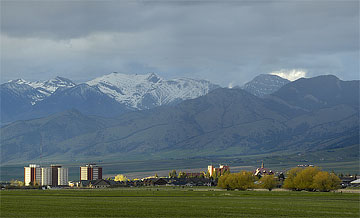 Last week I visited Montana State University along with my son. He is interested in attending film school for college, and Montana State has a well-regarded program in film, television, and theatre. Not surprisingly, one of the most attractive features of Montana State is its location in Bozeman, a delightful town with fantastic winter sports opportunities nearby. The folks at the university were friendly and informative, and we left with an overall positive impression.
Last week I visited Montana State University along with my son. He is interested in attending film school for college, and Montana State has a well-regarded program in film, television, and theatre. Not surprisingly, one of the most attractive features of Montana State is its location in Bozeman, a delightful town with fantastic winter sports opportunities nearby. The folks at the university were friendly and informative, and we left with an overall positive impression.
I did notice a couple of fun signs on campus, and thought I’d share them with you. The first was in one of the dorms. It gets right down to business.

The second sign appeared on the doors of the student center. Notice especially the final prohibition.

It’s good to know that there won’t be any grizzly bears in the student center. (Or, perhaps, folks from the University of Montana, who are known as the Grizzlies.) At any rate, you’ve got to appreciate a college administration with a sense of humor.
Topics: Vacation | 2 Comments »
Montana Countryside Outside of Bozeman
By Mark D. Roberts | Wednesday, August 26, 2009
The following photos need no explanation . . . .
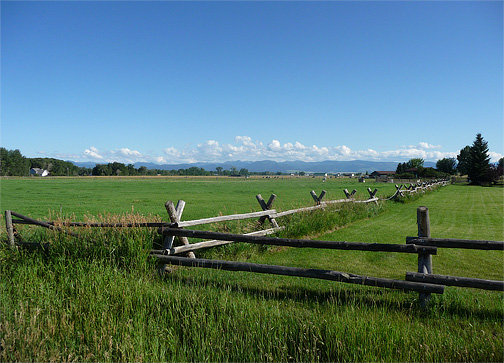
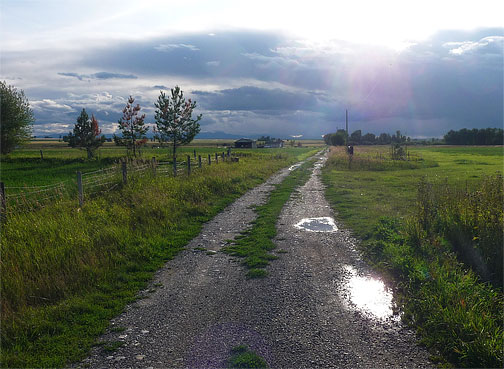
Topics: Vacation | No Comments »
Hike to Lava Lake
By Mark D. Roberts | Tuesday, August 25, 2009
During our recent trip to Montana, my family and I, along with several friends, hiked to Lava Lake. This 5.5 mile hike involved a substantial climb (1600 ft) along a fast-moving creek. The forest was dense and lush. The trailhead is about a half-hour south of Bozeman, on the edge of the Lee Metcalf Wilderness. If you’re in the area, this is a hike well-worth taking. Here are a couple of photos from the hike.
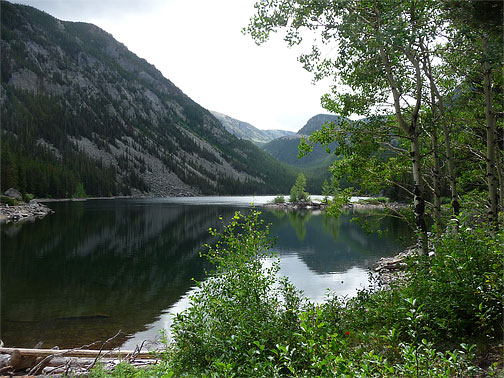
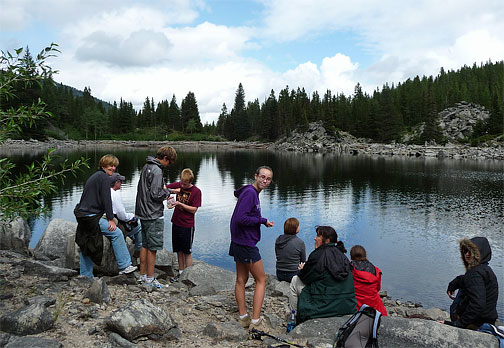
Remember, when you’re hiking in Montana, you’re in grizzly bear country. Be sure to hike in groups, and it doesn’t hurt to have some bear spray with you, just in case.
Topics: Vacation | No Comments »
Fun Photos from Vacation
By Mark D. Roberts | Monday, August 24, 2009
My son and his friend chase the cattle off of our trail in the Montana mountains . . . .
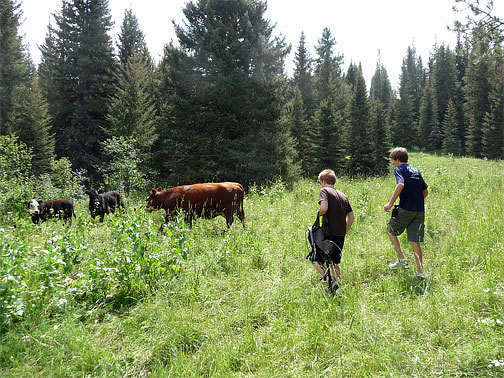
Who says there are palm trees in Montana?
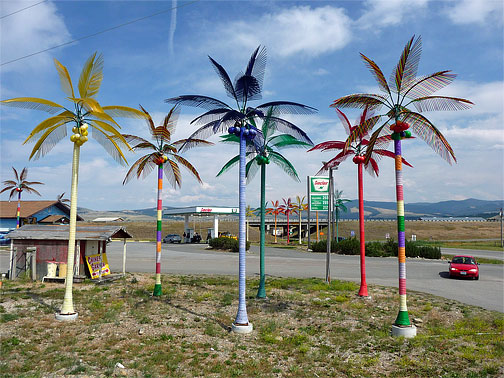
Topics: Vacation | 3 Comments »
Sunday Inspiration from The High Calling
By Mark D. Roberts | Sunday, August 23, 2009
Keep on Praying
”Keep on asking, and you will receive what you ask for. Keep on seeking, and you will find. Keep on knocking, and the door will be opened to you.”
The New Living Translation of Matthew 7:7 adds “keep on” to the more common trio of imperatives (ask, seek, knock). This is not a creative paraphrase, however. If anything, it is a literal rendering of the underlying Greek verbs, which are present imperatives. The present imperative in Greek entails a sense of ongoing action, rather than a singular event. Jesus is not saying “Pray once and that’s it.” Rather, he is teaching us to pray, and to keep on praying. This is a call to persistent prayer.
Why should we continue praying, especially in times when it seems as if God is not even hearing us? (All Christians go through times like these.) In part, we pray and keep on praying in sheer obedience to Jesus. But he also gives us a series of promises. If we keep on asking, we will receive. If we keep on seeking, we will find. And if we keep on knocking, the door will be opened.
Yet it isn’t our perseverance in prayer that accounts for the answers. In the next paragraph of Matthew, Jesus explains that God answers prayer because he is our Heavenly Father who loves to give good gifts to his children (vv. 9-11).
QUESTIONS FOR REFLECTION: Do you pray and keep on praying? What makes it hard to be persistent in prayer? What helps you to pray?
PRAYER: Gracious Lord, thank you for this encouragement to pray. I need this today! I don’t find it hard to bring my needs and concerns before you. But persistence in prayer can be a challenge. After a few times of praying for something, I can lose heart. Honestly, it’s hard to keep on praying when it seems as if you aren’t even listening.
Thank you for the promise that the one who asks and keeps on asking will receive. Though I realize prayer isn’t a simple equation, whereby I get exactly what I want, I hold tightly to the promise that you will answer me when I pray. Your answers may be surprising. But they will come in time.
So help me, Lord, to pray and keep on praying. Amen.
_________________________________________________
 Would you like to receive a Daily Reflection like this one in your email inbox each morning?
Would you like to receive a Daily Reflection like this one in your email inbox each morning?
Here’s how . . . .
This devotional comes from The High Calling of Our Daily Work (www.thehighcalling.org), a wonderful website about work and God. You can read my Daily Reflections there, or sign up to have them sent to your email inbox each day. This website contains lots of encouragement for people who are trying to live out their faith in the workplace.
Topics: Sunday Inspiration | 1 Comment »
How Things Change . . .
By Mark D. Roberts | Saturday, August 22, 2009
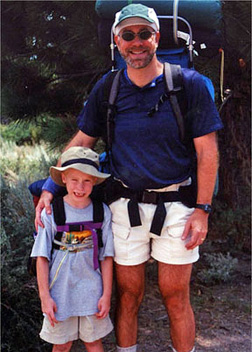 Yesterday I put up a photo of my son, Nathan, and me at the beginning of our first backpacking trip together. I believe that picture was taken in the summer of 2000. Here’s another look at that photo.
Yesterday I put up a photo of my son, Nathan, and me at the beginning of our first backpacking trip together. I believe that picture was taken in the summer of 2000. Here’s another look at that photo.
We were at the trailhead for the Sherman Lakes trail out of Mammoth Lakes in California. It was a steep hike, quite dusty. Poor Nathan had a bad cough. Not only that, he was also struggling with childhood asthma, though we didn’t know it at the time. Nevertheless, we had a fantastic trip, a marvelous father-son outing. I still have many precious memories of that time with Nathan.
 Earlier this week Nathan and I took another hike, along with some friends. This time we were in Montana, hiking to Pioneer Falls. We hiked south along Spanish Creek, then took a right fork on a trail that paralleled Falls Creek. The meadows along the way were stunning. If you’re ever in the Bozeman area, I highly recommend this hike. It’s about six miles long and not too steep. The drive to the trailhead is worth the trip. You pass through a gorgeous section of Ted Turner’s Flying D Ranch, where you see lots of bison enjoying their lunch. At any rate, here’s a photo of Nathan and me on our recent hike.
Earlier this week Nathan and I took another hike, along with some friends. This time we were in Montana, hiking to Pioneer Falls. We hiked south along Spanish Creek, then took a right fork on a trail that paralleled Falls Creek. The meadows along the way were stunning. If you’re ever in the Bozeman area, I highly recommend this hike. It’s about six miles long and not too steep. The drive to the trailhead is worth the trip. You pass through a gorgeous section of Ted Turner’s Flying D Ranch, where you see lots of bison enjoying their lunch. At any rate, here’s a photo of Nathan and me on our recent hike.
As I said, “How things change . . . .”
Topics: Vacation | 3 Comments »
Intimate Fellowship and Complete Joy
By Mark D. Roberts | Friday, August 21, 2009
Part 21 of series: What is the Christian Life?
Permalink for this post / Permalink for this series
I began this series by looking at the sad situation that motivated John to write his first letter. Poor theology plus unloving behavior had led some members of his church to depart, leaving behind their former brothers and sisters in Christ. Koinonia, fellowship with God and God’s people, had been broken. John wrote in order to keep others in his congregation from joining the separatists. He reminded his people about the “Word of life” revealed by God. If they held fast to this word, they would experience the fullness of the Christian life. That is to say, they would “have fellowship with us. And our fellowship is with the Father and with his Son, Jesus Christ” (1 John 1:3). John wrote to preserve and protect the koinonia so central to Christian living.
But he claimed to be writing for a further reason: “so that our joy will be complete” (1 John 1:4). Although John had deep fellowship with God, and though he had probably known Jesus personally as his “beloved disciple” (John 19:26), John’s joy depended upon his fellowship with other Christians. “Our joy” in this verse, means “your joy and my joy, together.” John wrote, not only so that he might be joyful, but that he and his spiritual children might know the fullness of joy. Only if they share together in fellowship with God, would their joy be complete. Maximum joy follows from genuine koinonia.
It is especially striking to consider John’s admission that his joy depends on his relationship with his church. If John knew Jesus personally, if he walked with Jesus and was his “beloved disciple,” and yet John’s joy was incomplete apart from fellowship with other Christians, how much more will this be true for us. Comprehensive joy is always a corporate experience. Although God can surely give joy to the heart of a solitary Christian, complete joy requires a rejoicing community. Joy is even better when it is shared.
I’m reminded of an experience I had years ago in the High Sierra mountains of California. Just about nothing else in life causes me to rejoice like the majestic grandeur of the Sierra, with peaks soaring over 12,000 feet. Several years ago, my family and I spent a week in these sublime mountains. One afternoon I set off by myself for a sightseeing hike to Sherwin Lakes. Without my young children tagging along, nothing interrupted my brisk pace or my alpine meditations. I saw plenty of sights and still had time to drink in the inspiring scenery. Sheer granite peaks, pungent cedar forests, sparkling blue lakes . . . I was just about in heaven. Could I be more joyful than this?
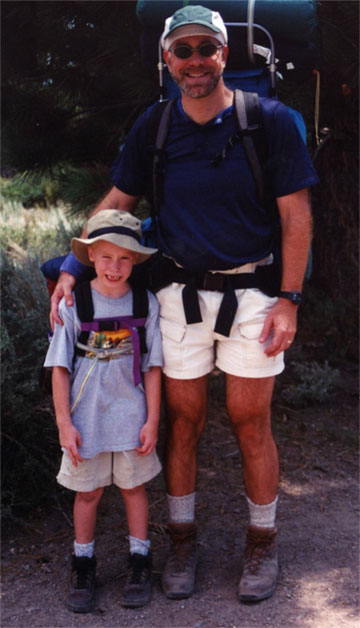 Yes, in fact, I could be. The next day I loaded my backpack with all the provisions for an overnight stay at Sherwin Lakes. But this time I didn’t go alone. My six-year-old son Nathan accompanied me for his first backpacking trip. With him as my partner, I didn’t hike as quickly, that’s for sure. I didn’t see as many sights as I had seen when walking alone or have the leisure to appreciate them without distraction. But my joy was even more supreme than it had been because it was now shared. I could show Nathan the cliffs that had stirred my soul the day before, and he could marvel at them with me: “Dad, they’re just hunormous!” Nathan helped me to get pleasure from natural trifles I had overlooked just a few hours earlier: pine cones, water bugs, and sticks just right for throwing. Every aspect of that trip thrilled my son, whether we were gathering wood for the campfire or bundling up in our sleeping bags. My joy was more complete than it had been the day before because it was magnified through fellowship with someone I love.
Yes, in fact, I could be. The next day I loaded my backpack with all the provisions for an overnight stay at Sherwin Lakes. But this time I didn’t go alone. My six-year-old son Nathan accompanied me for his first backpacking trip. With him as my partner, I didn’t hike as quickly, that’s for sure. I didn’t see as many sights as I had seen when walking alone or have the leisure to appreciate them without distraction. But my joy was even more supreme than it had been because it was now shared. I could show Nathan the cliffs that had stirred my soul the day before, and he could marvel at them with me: “Dad, they’re just hunormous!” Nathan helped me to get pleasure from natural trifles I had overlooked just a few hours earlier: pine cones, water bugs, and sticks just right for throwing. Every aspect of that trip thrilled my son, whether we were gathering wood for the campfire or bundling up in our sleeping bags. My joy was more complete than it had been the day before because it was magnified through fellowship with someone I love.
That’s the way it is in the Christian life. I’ve seen it again and again. A mother leads her daughter to Christ, but isn’t overwhelmed with tears of joy until she shares her good news with the members of her small group, who add plenty of their own tears to the gladsome puddle. A man returns to church after a long illness and is welcomed back with jubilation by those who had been praying for him so faithfully. His personal joy becomes their shared celebration. The biblical command to “rejoice with those who rejoice” is not some burden to be borne, but an invitation to more abundant living (Rom 12:14, NIV).
The Christian life is intimate fellowship with God and God’s people. It touches and transforms every aspect of our lives, beginning at the moment we believe in Jesus, and continuing into eternity. The more we experience true koinonia, the more our lives will be characterized by joy.
Topics: Christian Life | No Comments »
Hiking in Montana
By Mark D. Roberts | Thursday, August 20, 2009
Here are a couple of photos from a hike that my wife and I took while on vacation in Montana. The hike was in Flathead National Forest, not far from Swan Lake.
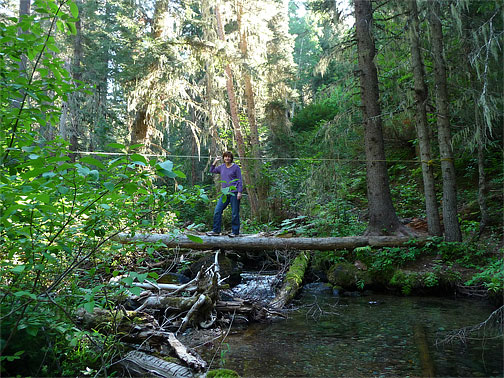
It was certainly nice of somebody to string that rope across the log bridge.

Some wild turkeys on a fence. I think these are Merriam’s Wild Turkeys (Meleagriseagris gallopavo merriami).
Topics: Vacation | 3 Comments »
Intimate Fellowship Encompasses Four Common Ideas of the Christian Life (Section 2)
By Mark D. Roberts | Wednesday, August 19, 2009
Part 11 of series: What is the Christian Life?
Permalink for this post / Permalink for this series
In my last post in this series I began to examine several common ideas of the Christian life and their relationship to intimate fellowship. These ideas included:
1. The Christian life is being in heaven after death.
2. The Christian life is feeling joy and peace in the Lord.
3. The Christian life is believing the right things about God and Jesus.
4. The Christian life is doing what God commands in his Word.
I showed that intimate fellowship includes the first and second ideas in this list. Today I’ll consider the third and fourth notions of the Christian life.
3. The Christian Life as Believing the Right Things?
Proponents of Idea #3 highlight the content of faith. For them, the Christian life is believing the right things about God. From John’s perspective, right belief leads to genuine koinonia, but is not equivalent to it. He declares the “Word of life,” the message of God’s life in Christ, so that we may live in fellowship with God and God’s people (1 John 1:1-3). Koinonia is not some squishy, subjective relationship with a god of our own formulation. It is a substantive, spiritual relationship with the one God who has revealed himself in Jesus Christ, and who is known through the declaration of “the Word of life.”
Yet, the Christian life is not the same thing as right belief. Rather, it is the relational result of right belief. We know God in truth, but our knowledge of God is not merely intellectual. We don’t just know about God. We also know God, personally, intimately. To the extent that we know God truly, our relationship with God will be deeper and more authentic. So right belief leads to deeper relationship. But right belief is not the essence of the Christian life so much as an essential component and facilitator of it.
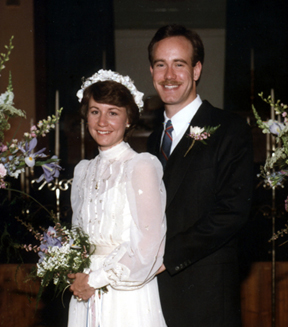 Once again, we should not that relationship with God is quite a bit like a marriage. The more I know about my wife – her tastes, her beliefs, her fears, her history, her passions – the more I am able to have intimate fellowship with her. But knowing these facts is not the same as the relationship. So it is with right theology. It can lead us into deeper fellowship with God, but is not the same as that fellowship. (For the record, I do know a bit more about my wife than when this photo was taken 25 plus years ago.)
Once again, we should not that relationship with God is quite a bit like a marriage. The more I know about my wife – her tastes, her beliefs, her fears, her history, her passions – the more I am able to have intimate fellowship with her. But knowing these facts is not the same as the relationship. So it is with right theology. It can lead us into deeper fellowship with God, but is not the same as that fellowship. (For the record, I do know a bit more about my wife than when this photo was taken 25 plus years ago.)
4. The Christian Life as Doing What God Commands
To be sure, Christian living includes doing what God commands. True fellowship with God, as we have seen, impacts our whole life. Our way of walking – our daily behavior – will reflect our relationship with God. We will do what God commands as a result of our intimacy with him.
A lifestyle of perpetual disobedience proves the lack of such intimacy. Yet because the Christian life is not exactly the same as obedience, individual acts of disobedience do not kill that life. If we “live in the light,” if we do what God commands, not only do “we have fellowship with each other,” but also “the blood of Jesus, his Son, cleanses us from every sin” (1 John 1:7). Because our relationship with God depends upon his grace in Christ and not upon our acts of obedience, occasional sin is more like a bad flu than a terminal illness. Koinonia with God not only heals our sickness, but it also vaccinates us from the virus of sin.
Often, Christians have a hard time figuring out how doing what God commands fits with intimate fellowship with God. Some Christians fall into the pit of legalism, turning the Christian life into a list of dos and don’ts. They promise intimacy with God only on the basis of our actions. Other Christians, however, completely disconnect intimate fellowship with God from obedience. They buy into a false notion that our actions are basically irrelevant when it comes to our relationship with God.
In fact, doing good works that glorify God is part and parcel of the Christian life. But it comes in the context of a grace-based relationship with God. No text of Scripture makes this clearer than Ephesians 2:8-10:
For by grace you have been saved through faith, and this is not your own doing; it is the gift of God — not the result of works, so that no one may boast. For we are what he has made us, created in Christ Jesus for good works, which God prepared beforehand to be our way of life.
By grace we are brought into relationship with God through faith. As we live in this intimate fellowship with God, we live our lives for his glory, doing the good works that he has prepared for us. The works are a result of grace, an outgrowth of our relationship with God.
When we begin to live the authentic Christian life, when we experience each day as intimate fellowship with God and his people, our lives become richer and more joyful. I’ll say more about this in my next post in this series.
Topics: Christian Life | 2 Comments »





